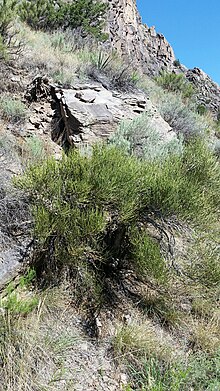| Ephedra cutleri | |
|---|---|

| |
|
Scientific classification
| |
| Kingdom: | Plantae |
| Clade: | Tracheophytes |
| Clade: | Gymnospermae |
| Division: | Gnetophyta |
| Class: | Gnetopsida |
| Order: | Ephedrales |
| Family: | Ephedraceae |
| Genus: | Ephedra |
| Species: | E. cutleri
|
| Binomial name | |
| Ephedra cutleri | |
| Synonyms [1] | |
| |
Ephedra cutleri, the Navajo ephedra or Cutler's jointfir, is a species of Ephedra that is native to the Southwestern United States ( Arizona, New Mexico, Utah, Colorado, Nevada, Wyoming). [1] [2]
Description
The rhizomatous shrubs form erect clumps, .25–1.5 metres (0.82–4.92 ft) tall and 3–5 metres (9.8–16.4 ft) wide. It grows on flat and dry sandy areas, and occasionally on rocky slopes. [3] Anchored by the rhizomes and an advantageous root system, Ephedra cutleri leaves grow in an opposite orientation but can not sustain all growth. Because the leaves are too small to perform photosynthesis, it is conducted in the sticky stems of the plant. [4]
Cultivation
In one study, E. cutleri was the major plant found in Northeastern Arizona where dry, loamy, fine sand surfaced layers of Sheppard series soils [5] dominate and form coppice dunes due their strong rhizomes. [6]
Stabilized dunes are preferred at higher elevations. [7]
Evapotranspiration of waste water studies have been performed where E. cutleri is the predominant established plant species. Their adaptation to the arid conditions of the desert landscape provide ideal functionality of evaporating the deposited water. [8]
Uses
A food source for animals, there are differing views as to whether the plant has any medicinal properties for humans with the exception of brewing Mormon tea. [4] Another source indicated the stems contain ephedrine which can be used to treat respiratory symptoms. [9]
Native Americans in the Four Corners region have made use of the plant in various ways. The seeds were sometimes roasted and ground into flour, while the plant could also be used for making light tan or reddish dyes, as well as used in the process of tanning animal hides. [10]
Taxonomy
The plant was originally described by Robert Hibbs Peebles in 1940. It was placed in section Ephedra sect. Asarca. [11]
The formation of the mountains and arid climatic variation conditions of the Southwestern United States and provides and ideal environment for the Ephedra species to develop. E. cutleri has diverged along with other variants such as E. californica and E. viridis during the Late Miocene and Pliocene epochs from one of the original Ephedra species E. distachya. [7]
Distribution
USA (AZ, CO, NM, UT, WY) [12] [2]
Dispersal method is normally small mammals. [7]
Wetland Indicator
Not determined [13]
References
- ^ a b Kew World Checklist of Selected Plant Families
- ^ a b Biota of North America Program, 2013 county distribution maps
- ^ Ephedra cutleri in Flora of North America @ efloras.org
- ^ a b "Southwest Colorado Wildflowers, Ephedra". www.swcoloradowildflowers.com. Retrieved 2018-10-05.
- ^ "Official Series Description - SHEPPARD Series". soilseries.sc.egov.usda.gov. Retrieved 2018-11-14.
- ^ Hodgkinson, Harmon S. (May 1983). "Relationship between Cutler Mormon-Tea [Ephedra cutleri] and Coppice Dunes in Determining Range Trend in Northeastern Arizona". Journal of Range Management. 36 (3): 375–377. doi: 10.2307/3898491. hdl: 10150/645912. JSTOR 3898491.
- ^ a b c Loera, Israel; Sosa, Victoria; Ickert-Bond, Stefanie M. (November 2012). "Diversification in North American arid lands: Niche conservatism, divergence and expansion of habitat explain speciation in the genus Ephedra". Molecular Phylogenetics and Evolution. 65 (2): 437–450. doi: 10.1016/j.ympev.2012.06.025. PMID 22776548.
- ^ Glenn, Edward P.; Jarchow, Christopher J.; Waugh, W. Joseph (October 2016). "Evapotranspiration dynamics and effects on groundwater recharge and discharge at an arid waste disposal site". Journal of Arid Environments. 133: 1–9. Bibcode: 2016JArEn.133....1G. doi: 10.1016/j.jaridenv.2016.05.003.
- ^ Bell, A.; Bachman, S. (2011). "Ephedra cutleri". IUCN Red List of Threatened Species. 2011: e.T201675A9162063. doi: 10.2305/IUCN.UK.2011-2.RLTS.T201675A9162063.en. Retrieved 2020-01-10.
- ^ National Park Service - Aztec Ruins, s.v. Jointfir - Ephedra spp.
- ^ Price, Robert A. (November 1996). "Systematics of the Gnetales: A Review of Morphological and Molecular Evidence". International Journal of Plant Sciences. 157 (S6): S40–S49. doi: 10.1086/297402. JSTOR 2475207. S2CID 85382873.
- ^ "Lady Bird Johnson Wildflower Center - The University of Texas at Austin". www.wildflower.org. Retrieved 2018-10-06.
- ^ "More Information and Sources | USDA PLANTS". plants.usda.gov. Retrieved 2018-10-07.
External links
Al Schneider - http://www.swcoloradowildflowers.com .
NatureServe Explorer - http://explorer.natureserve.org/index.htm Archived 2018-11-28 at the Wayback Machine
Integrated Taxonomic Information System - https://www.itis.gov/
USDA Natural resources Conservation Service - https://plants.usda.gov/core/profile?symbol=EPCU
